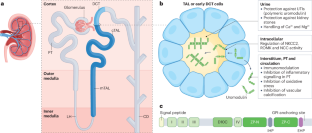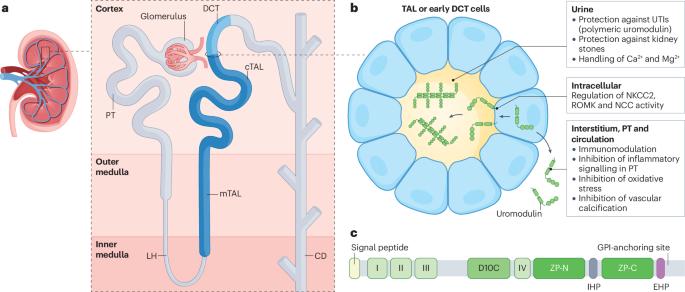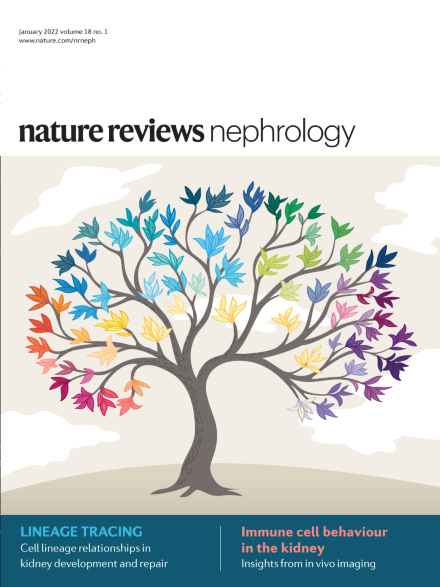尿调节蛋白生物学研究进展及潜在临床应用
IF 28.6
1区 医学
Q1 UROLOGY & NEPHROLOGY
引用次数: 0
摘要
尿肌球蛋白(又称 Tamm-Horsfall 蛋白)是一种肾脏特异性糖蛋白,可双向分泌到尿液中并进入血液循环,是正常尿液中含量最高的蛋白质。虽然尿肌球蛋白的发现早于现代医学,但它在健康和疾病中的意义却一直相当神秘。研究逐渐发现,尿肌球蛋白以多种形式存在,在泌尿系统和全身稳态中发挥着重要作用。尿液中的尿调节蛋白大多聚合成高度有组织的丝状物,而非聚合的尿调节蛋白在尿液和血液循环中均可检测到,并可发挥不同的作用。最初有报道称尿调素与免疫系统的相互作用是这种蛋白质的关键作用,现在人们对这种作用有了更深入的了解。此外,发现尿调节蛋白与一系列肾脏疾病(包括急性肾损伤、慢性肾病和常染色体显性肾小管间质性肾病)有关,进一步加快了对该蛋白作用的研究。这些发现提出了新的问题,开创了尿调节蛋白研究的新纪元。在此,我们将介绍尿调节蛋白生物学的最新发现及其在调节肾脏和全身性疾病中的新作用,并探讨未来的研究方向,包括其潜在的临床应用。本文章由计算机程序翻译,如有差异,请以英文原文为准。


Advances in uromodulin biology and potential clinical applications
Uromodulin (also known as Tamm–Horsfall protein) is a kidney-specific glycoprotein secreted bidirectionally into urine and into the circulation, and it is the most abundant protein in normal urine. Although the discovery of uromodulin predates modern medicine, its significance in health and disease has been rather enigmatic. Research studies have gradually revealed that uromodulin exists in multiple forms and has important roles in urinary and systemic homeostasis. Most uromodulin in urine is polymerized into highly organized filaments, whereas non-polymeric uromodulin is detected both in urine and in the circulation, and can have distinct roles. The interactions of uromodulin with the immune system, which were initially reported to be a key role of this protein, are now better understood. Moreover, the discovery that uromodulin is associated with a spectrum of kidney diseases, including acute kidney injury, chronic kidney disease and autosomal-dominant tubulointerstitial kidney disease, has further accelerated investigations into the role of this protein. These discoveries have prompted new questions and ushered in a new era in uromodulin research. Here, we delineate the latest discoveries in uromodulin biology and its emerging roles in modulating kidney and systemic diseases, and consider future directions, including its potential clinical applications. In this Review, the authors examine advances in uromodulin biology, including the existence of non-polymeric forms of the protein, its versatile functions, crosstalk with the immune system, its potential as a biomarker and its role in kidney disease, as well as considering how uromodulin might be targeted therapeutically.
求助全文
通过发布文献求助,成功后即可免费获取论文全文。
去求助
来源期刊

Nature Reviews Nephrology
医学-泌尿学与肾脏学
CiteScore
39.00
自引率
1.20%
发文量
127
审稿时长
6-12 weeks
期刊介绍:
Nature Reviews Nephrology aims to be the premier source of reviews and commentaries for the scientific communities it serves.
It strives to publish authoritative, accessible articles.
Articles are enhanced with clearly understandable figures, tables, and other display items.
Nature Reviews Nephrology publishes Research Highlights, News & Views, Comments, Reviews, Perspectives, and Consensus Statements.
The content is relevant to nephrologists and basic science researchers.
The broad scope of the journal ensures that the work reaches the widest possible audience.
 求助内容:
求助内容: 应助结果提醒方式:
应助结果提醒方式:


